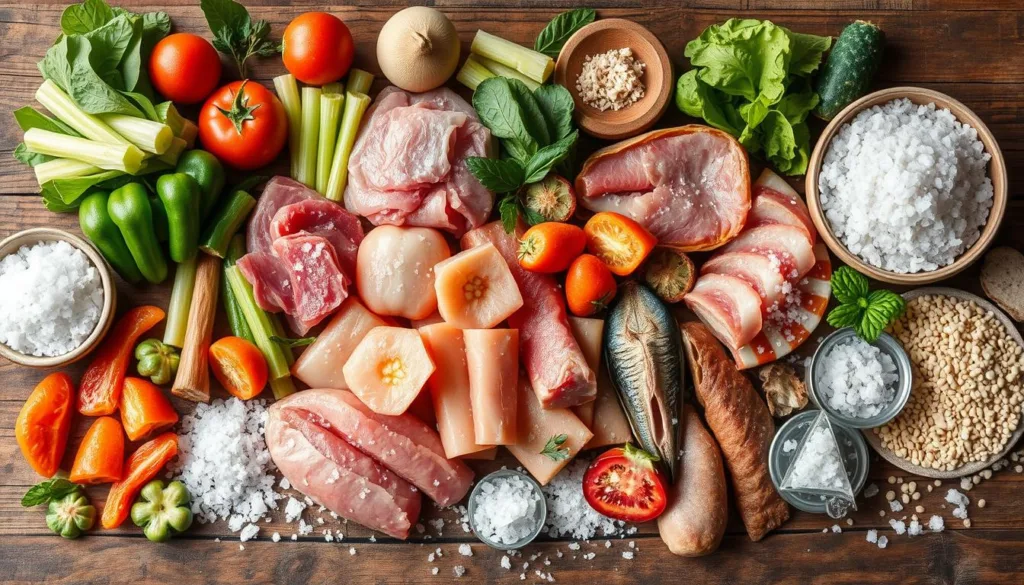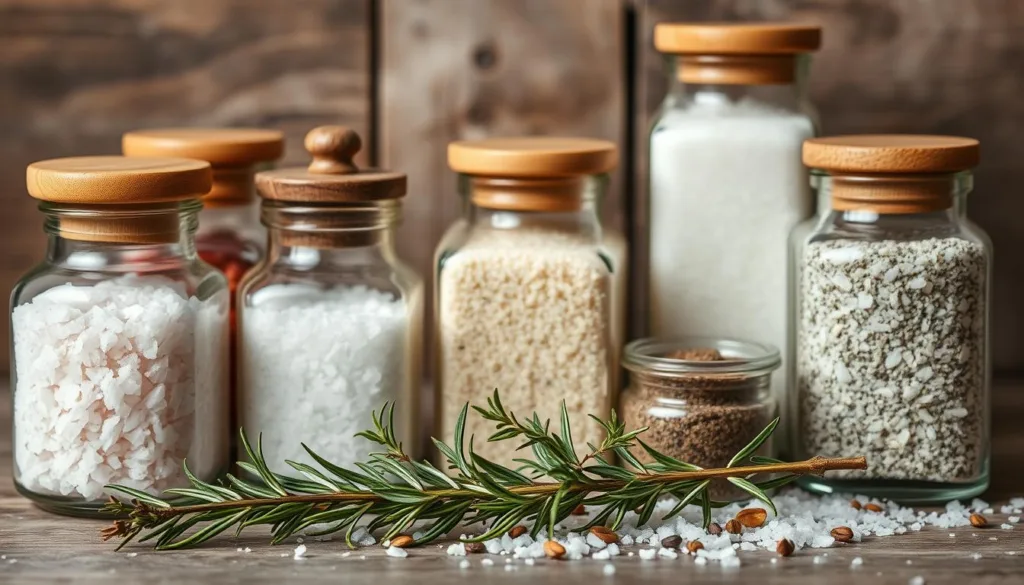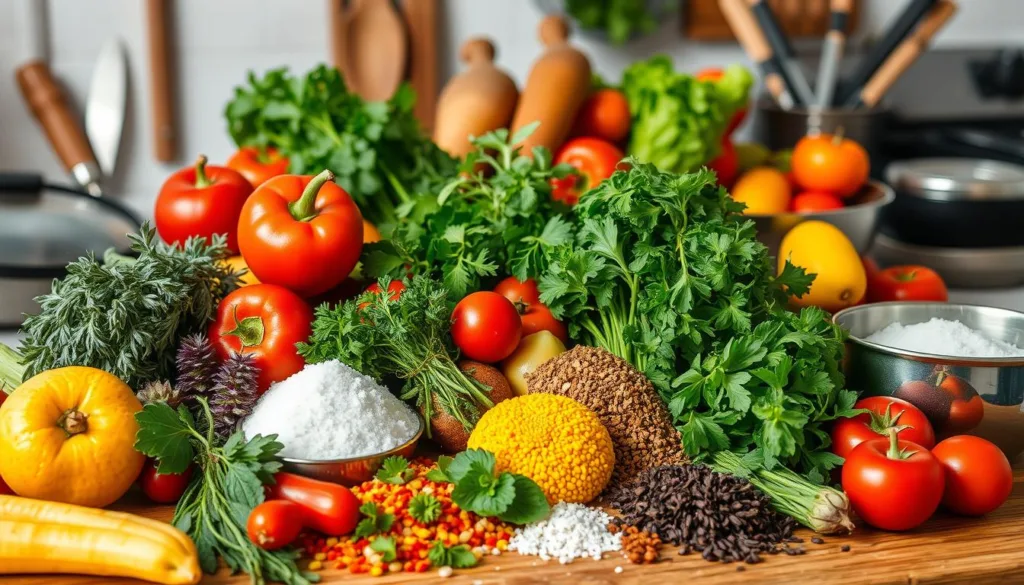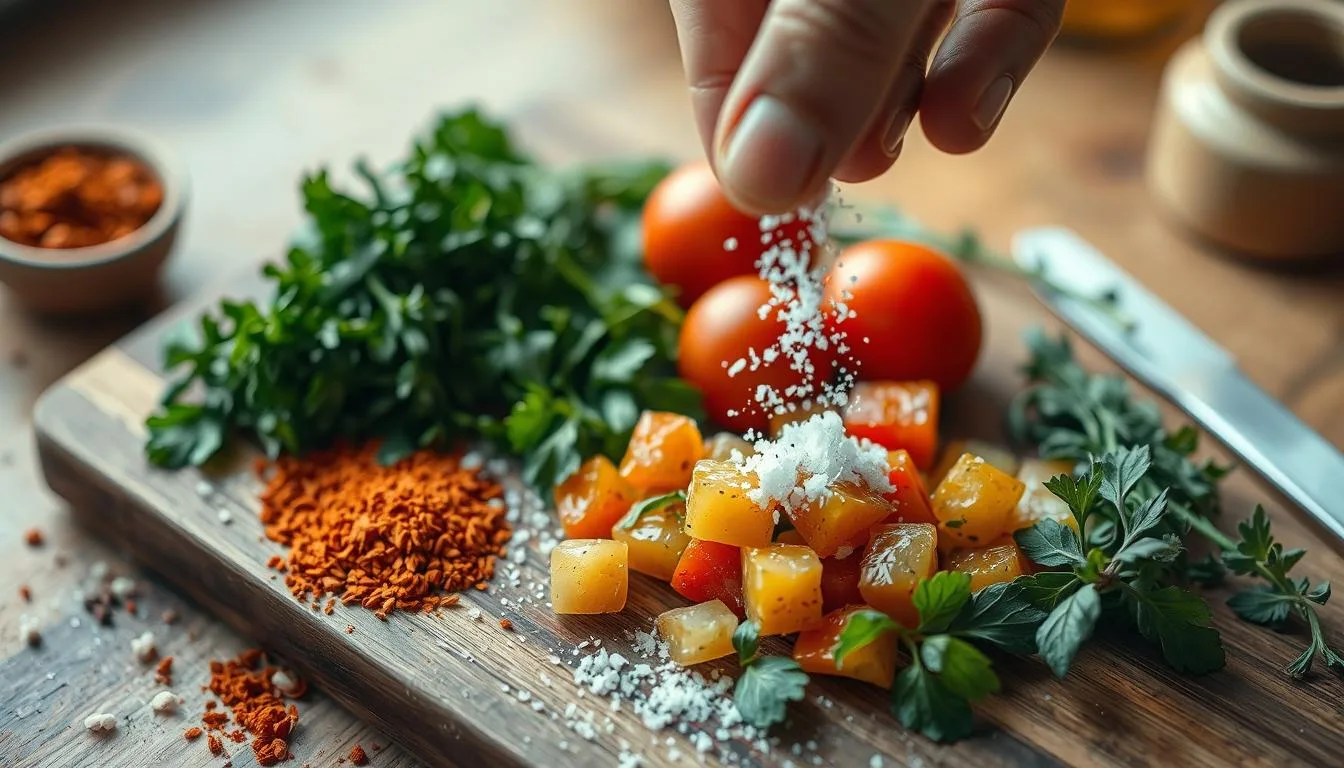Unlocking the secret to delicious meals starts with mastering salt as your primary flavor enhancer. The technique #1: season smarter with salt isn’t just about sprinkling crystals randomly—it’s a calculated approach. It transforms ordinary dishes into culinary masterpieces.
Salt does more than add taste. It amplifies the natural flavors in your ingredients, creating depth and complexity. This makes every bite memorable. Professional chefs know that seasoning is an art form, and salt is key in elevating your cooking.
Understanding how salt interacts with different ingredients can dramatically improve your kitchen skills. Whether you’re preparing vegetables, meats, or sauces, strategic salt application is crucial. It can make the difference between a good meal and an extraordinary dining experience.
By learning precise salting techniques, you’ll develop a nuanced approach to flavor enhancement. Your meals will showcase more vibrant tastes, balanced profiles, and restaurant-quality results. This will impress family and friends.
Understanding the Science Behind Salt and Flavor Enhancement
Salt is more than just a seasoning. It’s a culinary powerhouse that changes your cooking in amazing ways. Studies show that about 90% of cooks use salt to make flavors better. Lab tests say it can make flavors seem up to 30% stronger.
Adding salt to your dishes is like magic. It doesn’t just add its own taste. It also makes other flavors in your food better. Professional chefs know this well, with 75% saying salt is the most important seasoning.
How Salt Affects Taste Perception
Salt works with your taste buds in amazing ways. It can:
- Suppress bitter flavors
- Enhance sweet and umami tastes
- Activate salivary glands for better taste reception
Chemical Reactions in Cooking with Salt
The magic of salt goes beyond just adding flavor. It’s key in many cooking processes:
- Protein breakdown
- Moisture retention
- Texture modification
Types of Salt and Their Properties
| Salt Type | Flavor Profile | Best Uses |
|---|---|---|
| Sea Salt | Mineral-rich | Finishing dishes |
| Kosher Salt | Clean, pure | General cooking |
| Himalayan Pink Salt | Complex minerals | Decorative plating |
Knowing about salt’s science can make your cooking better. By learning these techniques, you can turn simple meals into amazing dishes.
“Salt is the difference between a good meal and a great one.” – Unknown Chef
The Art of Proper Salt Timing in Cooking
Mastering seasoning is key to improving your cooking skills. The right time to add salt can turn a simple dish into a masterpiece. Chefs know that when you add salt is as important as how much.
“Salt is the difference between a good meal and a great one.” – Culinary Wisdom
Each cooking stage needs a different seasoning approach. Your salt strategy should match the dish and cooking method. Here are key moments to consider salt addition:
- Before cooking: Helps proteins absorb flavor
- During cooking: Enhances overall taste profile
- Finishing: Adds final flavor complexity
Cooking tips say salting water for veggies can greatly enhance their taste. It’s recommended to salt water like the sea – about 3.5% salt by weight. Interestingly, chefs might use up to ten palmfuls of salt to get the right salinity.
| Cooking Stage | Salt Effect | Recommended Technique |
|---|---|---|
| Protein Preparation | Enhances moisture retention | Salt 30 minutes before cooking |
| Vegetable Boiling | Improves flavor absorption | Salt water like seawater |
| Final Touches | Intensifies surface flavor | Light sprinkle just before serving |
Pro tip: Experiment with salt timing to discover how it transforms your cooking. Each dish has its own perfect salt moment.
Technique #1: Season Smarter with Salt
Learning to season food well is key to improving your cooking. Salt does more than add flavor; it’s a skill that can make your dishes stand out.
During the quarantine, people started using salt in new ways. They tried out special salt mixes, like Scotch Bonnet Sea Salt Mix. This blend combines sea salt and Himalayan pink salt for richer flavors.
Layering Salt Throughout Cooking
Seasoning smarter means knowing when and how to use salt. Here are some tips:
- Start seasoning early in cooking
- Add salt a little at a time
- Keep tasting and adjusting
- Try different salts for unique tastes
Salt Distribution Methods
Getting salt to spread evenly is important. Chefs suggest:
- Pinch salt between your fingers for evenness
- Use a salt shaker for consistent coverage
- Make salt barriers in layered dishes
Measuring and Adjusting Salt Levels
Finding the right salt balance is an art. Start with less – you can always add more, but you can’t remove excess salt. Use measuring spoons and taste often to keep your dish flavorful.
“Salt is the difference between a good meal and a great one.” – Professional Chef
Essential Salt Guidelines for Different Food Groups
Learning to season food well is key to improving your cooking. Each type of food needs a special way to use salt. This ensures the best flavor and cooking techniques.

- Meats: Salt before cooking to enhance natural flavors
- Vegetables: Add salt gradually to control intensity
- Grains: Season sparingly to prevent overwhelming taste
- Baked goods: Precise measurements are critical
Knowing about sodium is important for cooking healthily. The average American eats over 3,400 mg of sodium a day. This is way more than the suggested 2,300 mg.
| Food Group | Sodium Recommendation | Cooking Tip |
|---|---|---|
| Vegetables | ≤230 mg per serving | Salt after cooking |
| Proteins | ≤480 mg per serving | Season before cooking |
| Grains | ≤230 mg per serving | Minimal seasoning |
“Salt is the difference between a good meal and a great one.” – Professional Chef Wisdom
Seasoning is an art. Keep practicing and tasting as you go. This will help you develop your cooking sense.
Maximizing Tomato Flavors with Strategic Salting
Salt is a powerful tool in cooking that can make tomatoes taste amazing. Learning how to season tomatoes right can take your cooking to the next level. It brings out the best flavors in both fresh and canned tomatoes.
Tomatoes are great for experimenting with salt. By mastering seasoning, you can make your dishes even better.
Salt Timing for Fresh Tomatoes
Fresh tomatoes need the right salting to shine. Here are some tips to make them sweeter:
- Sprinkle salt 10-15 minutes before serving
- Use kosher or sea salt for best results
- Allow salt to draw out natural moisture
Enhancing Canned Tomato Products
Canned tomatoes need a flavor boost. Salt can remove the metallic taste and add depth.
| Tomato Product | Salt Recommendation | Flavor Impact |
|---|---|---|
| Whole Canned Tomatoes | 1/4 teaspoon per can | Balanced, bright taste |
| Tomato Paste | Pinch of salt | Reduced acidic notes |
| Crushed Tomatoes | 1/2 teaspoon per can | Enhanced depth |
Roasting with Salt for Intensity
Roasting tomatoes with salt makes them even more flavorful. Sprinkle salt before roasting. It helps caramelize the sugars and adds a rich taste.
“Salt is the key to unlocking the hidden potential in every tomato.” – Professional Chef
Specialty Salts and Their Unique Applications
Exploring specialty salts opens a world of cooking techniques. Each salt adds its own flavor and character to dishes. This makes seasoning more than just adding salt.

From Fleur de Sel from French coasts to Himalayan pink salt from Pakistan, these salts do more than season. They offer unique textures, minerals, and flavors. These can make your cooking stand out.
- Himalayan Pink Salt: Contains 84 trace minerals, harvested from ancient sea salt deposits
- Fleur de Sel: Hand-harvested French sea salt known for delicate texture
- Black Lava Salt: Infused with activated charcoal from Hawaii
- Celtic Sea Salt: Traditionally harvested with mineral-rich properties
“Salt is the difference between a good meal and a great one.” – Anonymous Chef
When picking specialty salts, think about their unique qualities. Some are best as finishing salts, added just before serving. Others shine during cooking.
| Salt Type | Origin | Best Culinary Use |
|---|---|---|
| Fleur de Sel | France | Garnishing delicate dishes |
| Himalayan Pink Salt | Pakistan | Grilling and roasting |
| Black Lava Salt | Hawaii | Finishing gourmet plates |
Try these specialty salts to see how they can boost your cooking. A little of the right salt can turn a simple dish into a masterpiece.
Common Salting Mistakes to Avoid
Cooking can be tricky, especially with seasoning. Salt is key to tasty meals, but many make mistakes. These mistakes can ruin the flavor of your dishes.
Knowing common salting errors can improve your cooking. It makes you a more confident cook.
Over-Salting Prevention Tips
To avoid over-salting, pay attention and use smart cooking methods. Here are some tips:
- Add salt slowly and taste as you go
- Use measuring spoons for exact amounts
- Remember, you can add more salt, but it’s hard to take it out
Fixing Salt-Related Kitchen Disasters
Too much salt? Don’t worry. Here’s how to fix it:
- For soups and stews, add a peeled potato to soak up salt
- Dilute the dish with unsalted liquid
- Use lemon juice or vinegar to balance the saltiness
Best Practices for Salt Storage
Storing salt right keeps flavors and quality. Here’s what to do:
| Salt Type | Storage Recommendation | Shelf Life |
|---|---|---|
| Kosher Salt | Airtight container, cool dry place | Indefinite |
| Sea Salt | Sealed glass jar, away from moisture | 2-3 years |
| Iodized Salt | Tightly closed container | 5 years |
“Seasoning is an art, and mastering salt is the first step to culinary excellence.” – Professional Chef
Follow these tips and learn about seasoning. You’ll get better at cooking and make tastier meals with confidence.
Healthy Approaches to Salt Usage

Healthy cooking means using salt wisely. The average American eats over 3,400 milligrams of sodium each day. This is way more than the 2,300 milligrams the American Heart Association suggests.
Learning how to cut down on sodium is key for a balanced diet. Making smart salt choices is important for your health. It’s not just about cutting salt out of your meals.
“Salt is essential for flavor, but moderation is key to maintaining optimal health.” – Nutrition Experts
Smart Sodium Reduction Strategies
- Choose fresh ingredients over processed foods
- Read nutrition labels carefully
- Use herbs and spices as flavor enhancers
- Gradually reduce salt in recipes
Healthy cooking doesn’t have to be boring. With creative ways to cut sodium, you can make your meals tasty without overdoing it.
| Food Category | Sodium Content | Healthy Alternatives |
|---|---|---|
| Bread | High | Homemade, low-sodium varieties |
| Cheese | High | Reduced-sodium options |
| Processed Meats | Very High | Fresh, unseasoned meats |
Remember, mindful salt usage is about finding a balance. Try using salt substitutes, vinegar, citrus, and herbs to make meals that are good for your heart.
Salt Alternatives and Flavor Boosters
Healthy cooking doesn’t mean you have to give up flavor. You can make your meals exciting by trying new salt alternatives. These options add taste without using sodium.
It’s important to cut down on salt for your heart health. Luckily, many natural ingredients can make your food taste great. They also help you reach your wellness goals.
Herb and Spice Combinations
Discover a new world of flavor with these seasoning tips:
- Fresh herbs like basil, cilantro, and thyme
- Aromatic spices such as turmeric, cumin, and smoked paprika
- Dried herb blends for instant flavor enhancement
Natural Salt Substitutes
Find tasty salt alternatives that add a lot of flavor:
| Ingredient | Flavor Profile | Best Used In |
|---|---|---|
| Lemon Juice | Bright, Acidic | Seafood, Salads |
| Apple Cider Vinegar | Tangy, Sharp | Marinades, Vegetables |
| Nutritional Yeast | Cheesy, Umami | Vegetarian Dishes |
Building Flavor Without Excess Sodium
Building flavor needs creativity. Try roasting vegetables, using fresh garlic, ginger, and exotic spices. This way, you add depth without salt.
“Cooking is about celebrating ingredients, not drowning them in sodium.” – Culinary Expert
Using these salt alternatives, you can make healthier, tastier dishes. They will excite your taste buds and support your wellness journey.
Conclusion
Exploring technique #1: season smarter with salt is a journey of learning. Your cooking skills will grow as you use these tips and learn about salt’s role. Seasoning is not just about salt; it’s about adding depth and complexity to your dishes.
This guide offers a path to more confident cooking. By trying different salt amounts and timing, you’ll get better at seasoning. Your taste will improve, making your meals stand out with balanced flavors.
Salt is a key ingredient in your kitchen. Knowing how to use it can make simple meals special. Use these techniques, trust your taste, and see your cooking skills grow with each dish.
Your salt mastery journey begins today. Start practicing, exploring, and enjoy the tasty outcomes of your new skills in using salt and enhancing flavors.
FAQ
Why is salt so important in cooking?
Salt is key in cooking because it boosts flavors. It makes the natural taste of foods stand out. This makes dishes more enjoyable and complex.
How can I prevent over-salting my food?
Start with small amounts of salt and taste as you go. Use measuring tools for accuracy. Remember, it’s easier to add more salt than it is to remove it.
Consider using kosher or sea salt. They allow for better control over seasoning.
Are there healthy alternatives to using salt?
Yes, you can use herbs, spices, and other ingredients to add flavor without sodium. Fresh herbs, garlic, lemon zest, and spices can greatly enhance your dishes while keeping sodium levels low.
What’s the difference between various types of salt?
Different salts have unique qualities. Table salt is fine and uniform. Kosher salt has larger crystals and is less dense.
Sea salt contains trace minerals. Specialty salts like Himalayan pink salt or flaky Maldon salt offer distinct textures and flavors.
When should I add salt during cooking?
Salt timing depends on the dish. For meats, salting before cooking tenderizes and enhances flavor. For vegetables, add salt towards the end to keep them crisp.
In soups and stews, add salt throughout cooking to build flavor depth.
How can I reduce sodium in my diet while maintaining flavor?
Use herbs, spices, and acid-based ingredients like vinegar or citrus to add complexity. Gradually reduce salt in recipes. Use salt-free seasoning blends and opt for fresh ingredients with more natural flavor.
What’s the best way to salt tomatoes?
For fresh tomatoes, lightly salt just before serving to enhance their sweetness. When roasting, salt beforehand to caramelize and concentrate flavors. For canned tomatoes, add salt during cooking to boost their taste.
How do I store salt to maintain its quality?
Store salt in a cool, dry place in an airtight container. Keep it away from moisture and direct sunlight. Avoid storing near the stove where heat and steam can cause clumping.
For specialty salts, keep them in their original packaging or sealed containers. This preserves their unique properties.
Looking for more delicious recipes to try? Explore these amazing dishes on American Tasty:
- Red Lentil Soup with Warm Spices: A comforting, flavorful soup perfect for any season.
- Fishcakes and Scallops Stir-Fry Recipe: A quick and easy seafood dish with a savory twist.
- Chocolate Espresso Dacquoise: A decadent dessert that combines chocolate and coffee flavors.
- Crab Dip: A creamy, crowd-pleasing appetizer for any gathering.
- Pea Salad: A fresh, vibrant side dish that’s perfect for summer meals.
- Breakfast Lasagna: Start your day with a hearty and unique breakfast recipe.
- Pumpkin Soup: A rich, velvety soup that’s ideal for autumn evenings.
Each recipe offers a unique flavor experience—perfect for adding variety to your cooking! Click the links to discover step-by-step guides and tips to make these dishes at home. Happy cooking! 🍴

